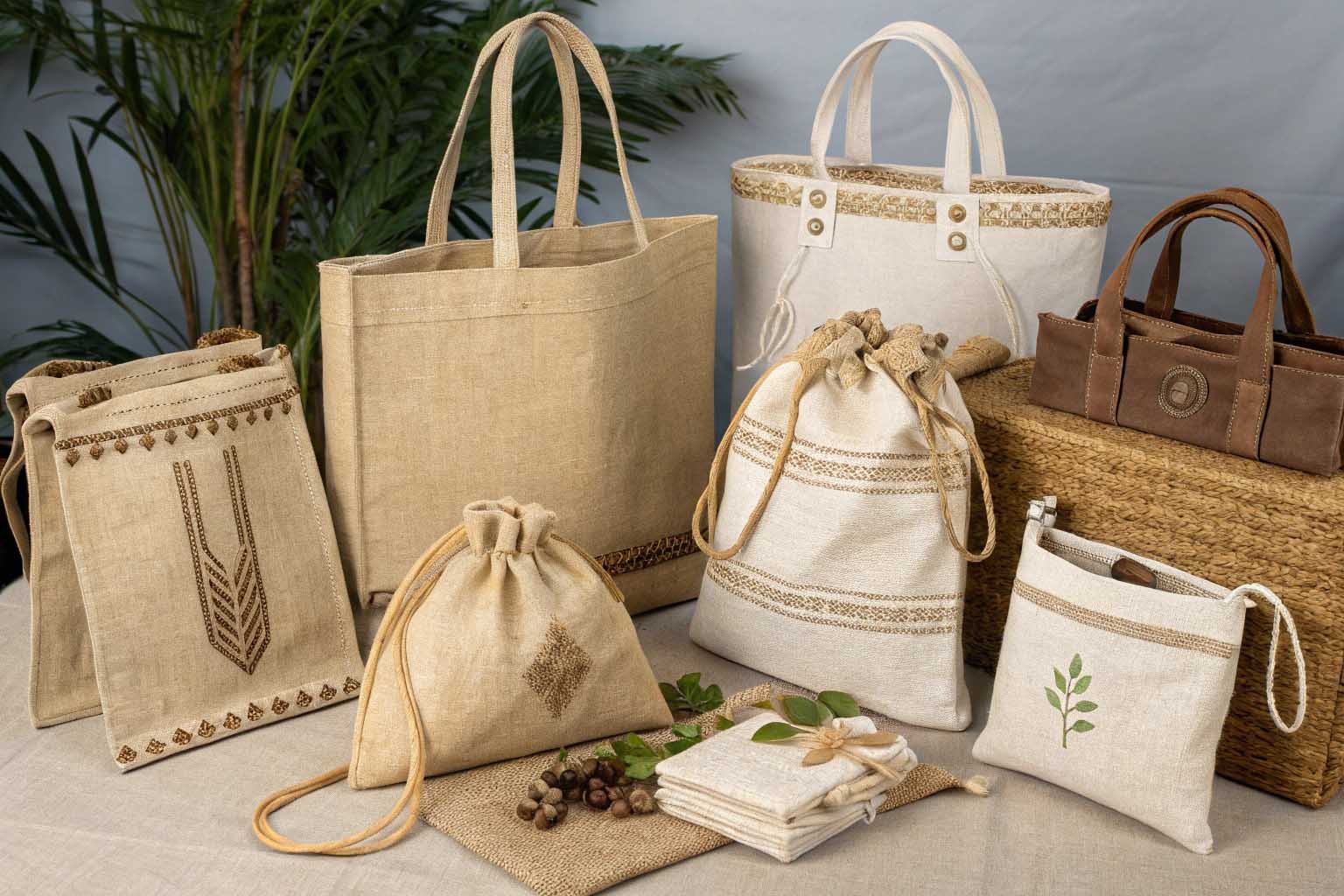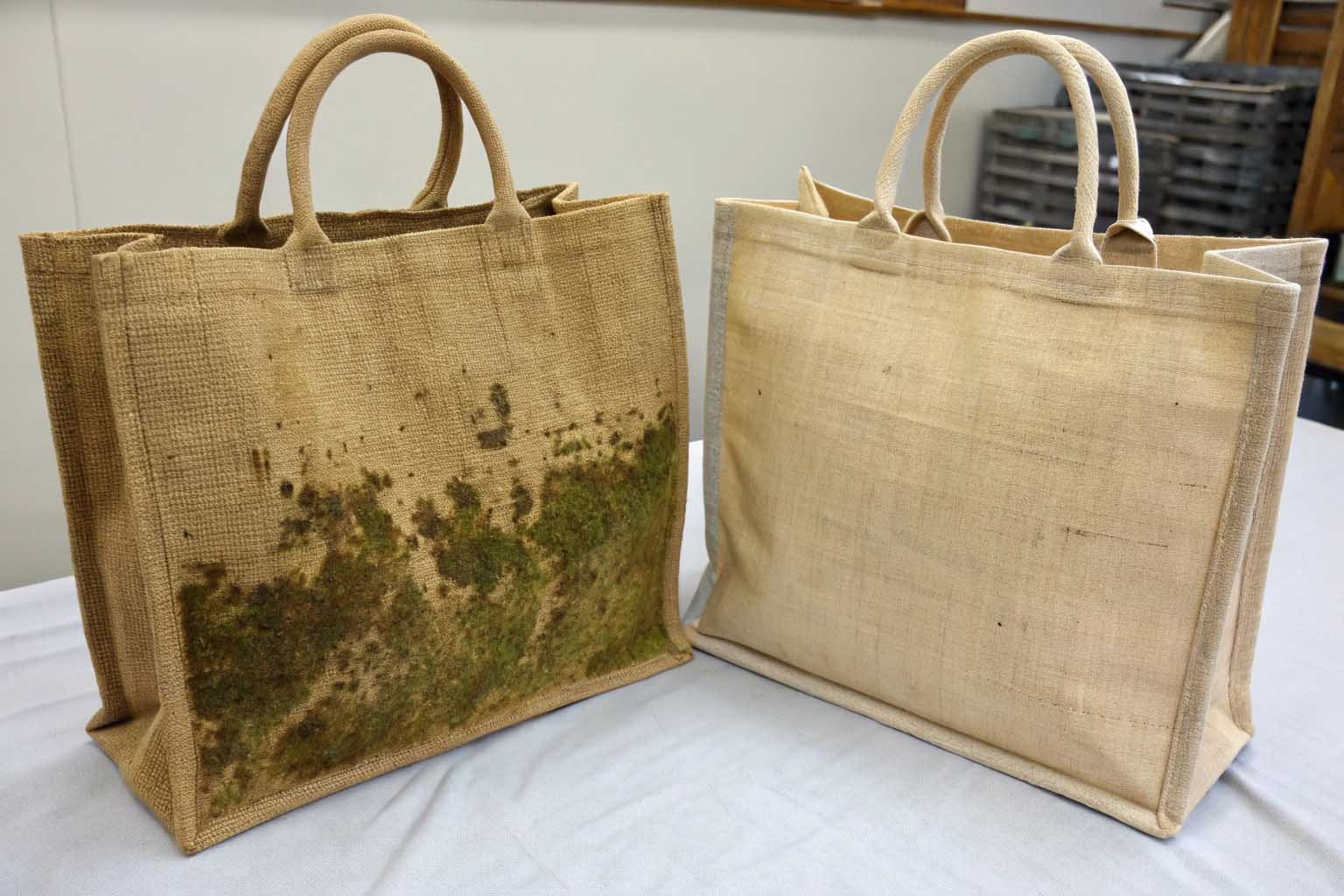Businesses are increasingly searching for sustainable packaging solutions, but not all eco-friendly materials perform equally. Jute bags offer impressive environmental credentials, but their practical limitations can catch many brands off guard, potentially compromising both functionality and customer satisfaction.
Jute bags provide excellent environmental benefits as they’re biodegradable, renewable, and carbon-negative. They offer strong durability for most everyday uses and an appealing natural aesthetic. However, they have limited water resistance, can be heavier than synthetic alternatives, may shed fibers, and aren’t suitable for all climate conditions.

Before diving into the specifics, I want to emphasize why this matters. In my years helping brands source sustainable packaging, I’ve seen countless companies rush into jute bag orders without understanding their full performance profile. By the end of this article, you’ll know exactly what jute can and cannot do for your brand or personal needs.
Are Jute Bags Water-Resistant or Suitable for Heavy Loads?
Pain points arise when businesses discover their jute bags failing in wet conditions or breaking under unexpected weight. Many assume natural means indestructible, but jute has specific physical properties that define its performance limits.
Natural jute bags have minimal water resistance and readily absorb moisture, which can weaken fibers and cause staining. However, jute bags with PE lining can provide significant water resistance. For weight capacity, standard jute typically handles 15-25 pounds (7-11 kg), while reinforced versions with PE lining and stronger handles can support up to 30-40 pounds (13-18 kg) and maintain better structural integrity.

Diving Deeper into Jute’s Water and Weight Performance
Understanding jute’s relationship with water has been crucial in my consulting work with brands. In its natural state, jute fibers1 are highly absorbent, which creates several performance issues2. However, the addition of a PE (polyethylene) lining transforms the bag’s functionality significantly.
Here’s how different jute constructions perform with moisture:
-
Natural Unlined Jute:
- Absorbs water quickly
- Can develop musty odors if not dried properly
- Experiences up to 20% reduction in tensile strength when wet
- Becomes susceptible to mildew and mold growth
- May transfer color or dyes onto contents when damp
-
PE-Lined Jute Bags:
- Provides a reliable moisture barrier between contents and exterior
- Maintains structural integrity when exposed to light rain or damp conditions
- Prevents staining of bag contents
- Creates a more rigid, structured bag shape
- Extends the bag’s functional lifespan by protecting jute fibers
For brands considering jute for their packaging needs, the PE lining option adds approximately 15-30% to production costs but delivers significantly improved performance. It’s worth noting that while this lining improves functionality, it does impact the bag’s overall biodegradability profile.
As for weight capacity, I’ve created this comparison table based on data from our manufacturing partners:
| Jute Bag Type | Average Weight Capacity | Wasserbeständigkeit | Best Use Cases |
|---|---|---|---|
| Standard unlined | 15-20 lbs (7-9 kg) | Minimal | Dry goods, light retail, indoor use |
| Reinforced unlined (double stitching) | 20-25 lbs (9-11 kg) | Minimal | Heavier dry goods, trade shows |
| PE-lined standard | 20-30 lbs (9-14 kg) | Mäßig | Grocery shopping with moisture protection |
| PE-lined heavy-duty | 30-40 lbs (13-18 kg) | Gut | All-weather use, heavier items |
| Jute-cotton blend with PE | 25-35 lbs (11-16 kg) | Gut | Premium retail, gift packaging |
For businesses planning to use jute bags for products that might face moisture exposure or require structural stability, I strongly recommend the PE-lined options based on extensive field testing with our clients.
How Long Can a High-Quality Jute Bag Last With Proper Care?
When brands invest in sustainable packaging, longevity becomes a key concern. Poor durability can undermine both environmental goals and customer satisfaction, leaving many uncertain about jute’s true lifespan.
A high-quality unlined jute bag with proper care typically lasts 1-3 years with regular use. Premium jute bags with PE lining can extend that lifespan to 3-5 years, offering better protection against moisture damage and maintaining structural integrity longer. Longevity depends on usage frequency, climate conditions, and proper cleaning protocols.

Diving Deeper into Jute Bag Longevity
During my factory visits across India and Bangladesh (major jute producing countries), I’ve observed significant variations in jute bag construction that directly impact longevity. The manufacturing process matters tremendously – properly processed jute fibers that undergo thorough retting (the process of separating fibers from the woody stem) create stronger, longer-lasting bags.
Key factors affecting jute bag lifespan include:
- Interior Construction: PE-lined bags consistently outlast unlined versions by 1-2 years under identical use conditions
- Fiber Quality: Premium bags use longer, softer jute fibers with fewer impurities
- Construction Techniques: Double-stitched seams with heavy-duty thread increase durability
- Handle Reinforcement: The bag’s weakest point is often where handles attach; better bags feature box stitching or metal grommets
- Storage Conditions: Keeping jute bags in dry, moderate temperature environments extends life
I’ve tracked the lifecycle of different jute bag qualities through client feedback and found this correlation between construction quality and lifespan:
| Construction Quality | Average Lifespan (Regular Use) | Manufacturing Characteristics |
|---|---|---|
| Basic unlined | 6-12 months | Single-stitching, basic handles, untreated |
| Mid-range unlined | 1-2 years | Reinforced stitching, stronger handles |
| Basic PE-lined | 1.5-3 years | Standard construction with PE lining |
| Premium PE-lined | 3-5 years | Double-stitching, heavy PE lamination, premium handles |
| Luxury/Designer lined | 4+ years | Multi-layer construction, leather handles, specialty treatments |
For proper care, I recommend spot cleaning with a damp cloth, avoiding machine washing for unlined jute, and storing bags in dry locations. For PE-lined bags, wiping with a mild detergent solution is possible without risking fiber damage. UV exposure will gradually fade colors, so keeping bags out of direct sunlight when not in use helps maintain appearance regardless of construction.
Do Jute Bags Fade or Deteriorate Quickly in Humid Climates?
Companies expanding into tropical or humid regions are often caught off guard by jute’s vulnerability to climate conditions. Without proper knowledge, this can lead to inventory losses and disappointed customers.
Natural unlined jute bags are highly susceptible to humidity and can deteriorate quickly in tropical climates, developing mold within 2-3 months in environments with 70%+ humidity. PE-lined jute bags perform significantly better, resisting moisture damage and maintaining structural integrity for 2-3 times longer in the same conditions. Colors fade more slowly on PE-lined versions as well.

Diving Deeper into Climate Effects on Jute
This topic hits close to home for me, as I’ve witnessed firsthand how climate impacts jute performance. During a business trip to Singapore, I discovered an entire warehouse of imported unlined jute products that had deteriorated significantly after just one monsoon season. In the same facility, PE-lined jute bags stored under identical conditions showed minimal damage. The combination of 85% humidity and temperatures consistently above 30°C (86°F) had created perfect conditions for microbial growth on the unlined products.
In humid environments, jute faces several challenges that PE lining helps address:
- Moisture Barrier: PE lining prevents direct contact between jute fibers and humid air
- Microbial Protection: The plastic layer inhibits mold and mildew growth that natural jute supports
- Structural Stability: Lined bags maintain their shape and rigidity despite ambient moisture
- Color Preservation: The PE layer helps protect dyes from humidity-accelerated fading
- Contents Protection: Provides a reliable barrier between bag contents and external moisture
Based on data collected from our distribution partners across different climate zones, here’s how different jute constructions perform:
| Climate Type | Avg. Humidity | Unlined Jute Lifespan | PE-Lined Jute Lifespan | Recommended Construction |
|---|---|---|---|---|
| Arid/Desert | <30% | 2-3+ years | 3-5+ years | Either construction suitable |
| Temperate | 30-60% | 1-2 years | 2-4 years | Either suitable; lining for premium applications |
| Subtropical | 60-70% | 6-12 months | 2-3 years | PE lining highly recommended |
| Tropical | >70% | 2-6 months | 1-2 years | PE lining essential; consider additional treatments |
For brands operating in humid regions, I recommend:
- Using PE-lined jute as the standard offering
- Considering thicker PE linings (150-200 gsm) for tropical markets
- Providing care instructions to customers that emphasize proper drying and storage
- For extremely humid environments, adding supplemental anti-microbial treatments even to lined products
While PE lining adds to production costs, it’s not merely optional in humid markets—it’s essential for maintaining product integrity and customer satisfaction.
What Are the Cost Differences Between Jute, Cotton, and Recycled PET Bags?
Balancing sustainability with budget constraints creates genuine anxiety for many businesses. Without clear cost comparisons, brands struggle to make financially sound decisions while meeting environmental goals.
Standard unlined jute bags typically cost 15-30% more than cotton and 5-15% more than recycled PET bags. PE-lined jute adds another 15-30% to base jute pricing. For a promotional tote (15"x16"), average wholesale costs are approximately $2.50-3.50 for unlined jute, $3.00-4.50 for PE-lined jute, $1.80-3.50 for cotton, and $2.00-3.70 for recycled PET.

Diving Deeper into Sustainable Bag Cost Analysis
Having negotiated hundreds of sustainable bag contracts, I’ve developed a comprehensive understanding of pricing structures across different materials. The cost equation isn’t simply about raw material prices—it incorporates labor intensity, production complexity, and market positioning.
Jute’s pricing structure is influenced by several factors:
- Labor-intensive harvesting and processing: Jute requires significant manual handling during cultivation and fiber extraction
- Geographic concentration: 85% of global jute production occurs in Bangladesh and India, creating supply chain dependencies
- Seasonal availability: Jute is harvested once annually, requiring inventory management and storage costs
- PE lining addition: The lamination process adds both material and labor costs but delivers significant performance benefits
Here’s a detailed cost breakdown based on current market rates for a standard promotional tote (minimum order of 1,000 pieces):
| Material Typ | Base Material Cost | Manufacturing Labor | Finishing/Treatment | Avg. Wholesale Price | Retail Markup |
|---|---|---|---|---|---|
| Basic Unlined Jute | $1.20-1.60 | $0.90-1.20 | $0.40-0.70 | $2.50-3.50 | 2.5-3x |
| PE-Lined Jute | $1.40-1.90 | $1.10-1.50 | $0.50-1.10 | $3.00-4.50 | 2.5-3x |
| Bio-Baumwolle | $0.90-1.40 | $0.60-1.20 | $0.30-0.90 | $1.80-3.50 | 2.5-3x |
| Recycled PET | $0.85-1.50 | $0.75-1.20 | $0.40-1.00 | $2.00-3.70 | 2.5-3x |
| Non-woven PP | $0.40-0.80 | $0.40-0.80 | $0.20-0.60 | $1.00-2.20 | 2-3x |
While PE-lined jute represents the highest upfront investment among these options, the cost analysis should be balanced against lifecycle value. The improved durability and functionality of lined jute can deliver better long-term value through:
- Extended usable lifespan – reducing replacement frequency
- Broader application range – suitable for more product types and conditions
- Higher perceived value – customers appreciate the improved functionality
- Reduced returns/complaints – fewer performance-related issues
For brands operating on tight budgets but wanting jute’s aesthetic and environmental benefits, I recommend considering:
- Selective use of PE-lined jute for premium offerings or moisture-exposed applications
- Hybrid approaches using lined jute for external panels with less expensive materials for interior components
- Testing both lined and unlined options with target customers to determine willingness-to-pay
Why Might Some Businesses Choose Non-Woven Fabric Over Jute?
Making material choices without understanding the full business implications can lead to costly missteps. Many sustainable-focused companies automatically opt for natural fibers without evaluating whether they truly meet operational needs.
Businesses often choose non-woven fabrics over jute because they’re 30-50% less expensive, consistently waterproof without additional treatments, lighter for shipping, available in wider color ranges, and easier to clean. Even compared to PE-lined jute, non-woven offers cost advantages, more predictable printing surfaces, potentially greater tensile strength, and suitability for food or medical applications.

Diving Deeper into Material Selection Considerations
After consulting with hundreds of brands on material selection, I’ve identified key business drivers that frequently tip the scales toward non-woven fabrics despite jute’s environmental advantages. This decision framework extends beyond simple cost calculations to encompass operational realities.
The primary reasons businesses select non-woven over even PE-lined jute include:
- Cost Efficiency: Non-woven remains 25-40% less expensive than PE-lined jute
- Supply Chain Reliability: Non-woven production facilities exist globally, reducing single-region dependency that affects jute (primarily from Bangladesh and India)
- Consistency: Non-woven materials provide standardized thickness, texture, and performance metrics
- Design Flexibility: Non-woven fabrics accept more specialized printing techniques and finishesx
- Weight Reduction: Shipping costs can be 20-30% lower for equivalent non-woven products compared to PE-lined jute
For specific industries, these considerations become particularly relevant:
| Industrie | Primary Concern | Material Typically Preferred | Reasoning |
|---|---|---|---|
| Food Service | Hygiene, cleanability | Non-woven PP | Even PE-lined jute has texture that can trap particles |
| Luxury Retail | Aesthetic, prestige | PE-lined premium jute | Natural luxury appearance with practical protection |
| Outdoor/Adventure | Weather resistance | Heavy PE-lined jute or non-woven | Both offer good moisture resistance, non-woven is lighter |
| Mass Retail | Cost efficiency, consistency | Non-woven PP | Lower cost and greater consistency at scale |
In my consultations with clients, I often recommend a hybrid approach where PE-lined jute bags are positioned as premium offerings while Vliesstoff options serve value segments. This strategy has proven particularly effective for brands with diverse customer bases.
One client in the specialty food sector initially insisted on using only natural jute bags for their olive oil gift sets. Despite using PE-lined products, they experienced customer complaints about oil staining when bottles leaked during shipping. After testing several alternatives, they ultimately implemented a dual-material strategy: PE-lined jute for in-store purchases and non-woven for e-commerce shipments, solving their practical issues while maintaining brand aesthetics where it mattered most.
For businesses making this decision, I recommend conducting a thorough analysis of:
- Your specific product requirements (weight, moisture exposure, etc.)
- Your customer expectations (environmental positioning, premium feel, etc.)
- Your operational constraints (budget, shipping considerations, etc.)
This balanced approach often leads to more sustainable business outcomes than rigid adherence to a single material solution.
Schlussfolgerung
After examining Jutesäcke from multiple angles, the key takeaway is clear: jute offers excellent sustainability credentials with some practical limitations. PE-lined jute provides significantly enhanced functionality, water resistance, and durability, though with some environmental trade-offs. By understanding these characteristics, you can make informed decisions about whether jute—lined or unlined—is right for your specific needs.
-
Exploring this link will provide insights into the unique characteristics and applications of jute fibers, enhancing your understanding of their benefits. ↩
-
Understanding these issues can help you make informed decisions when working with jute, ensuring better product quality and customer satisfaction. ↩


